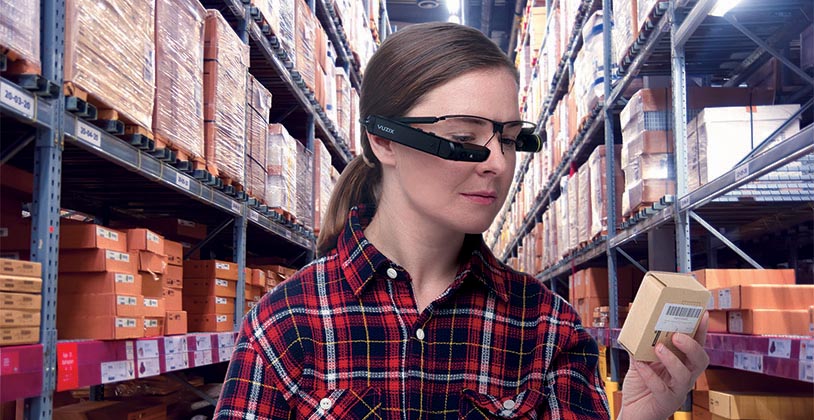Every facility has its top priorities. For some, it’s order turnaround time. Elsewhere, customer service reigns. Other places, on-time shipments top the list. It all depends on what a company and its customers prize most.
But, everyone agrees that equipment downtime derails any facility’s best efforts to deliver its top priority. Downtime is public enemy No. 1—especially if it is unexpected downtime.
What can be done about downtime? Some facilities are lucky enough to have dedicated, on-site service technicians. Experienced ones are best, especially if they aren’t close to retirement. But that’s not always the case in either regard.
That means waiting for a service technician to arrive and fix whatever went awry. Tick tock. Tick tock. You can watch the cost of downtime mount quickly.
That’s where smart glasses are coming into the picture. We all recall the Google glasses flop a few years ago. Don’t get hung up on that. The concept is making a comeback, and plants and warehouses are the most likely immediate beneficiaries.
“Smart glasses are for operations with high downtime costs where operational efficiency is a top priority,” says Pascal Waldvogel, leader of strategic projects at Kardex Remstar.
But it’s early in the age of smart glasses for maintenance. “We are still very much in the concept or pilot phase in June of 2018,” says David Krebs, vice president of research at the analyst firm VDC Research. “Progress is being made, and we expect to see meaningful deployment this year in the adoption of smart glasses specifically for maintenance,” he says.
And, with good reason. Smart glasses typically combine a video camera, augmented reality, microphone and a bar code scanner. The combination of these technologies in a lightweight, mobile, wearable, hands-free device is a downtime killer.
Wearing the glasses, even an inexperienced on-site technician can perform required maintenance immediately. With a Wi-Fi or Bluetooth connection, an experienced remote technician sees what the on-site person sees and guides the repair using augmented reality and voice directions. Suppliers typically compare the interface to iPhone’s FaceTime.
The combination of hands-free operation and access to both crucial maintenance information and guidance offers tremendous value, says Krebs. He adds that the ROI is real and fairly rapid.
Some suppliers say the cost of the glasses and service fee are covered in a single incident. Others say longer. But not much. Everyone agrees payback is less than a year.

Smart glasses basics
If there ever was a right time for the launch of smart glasses in maintenance, this is it. And that goes beyond the downtime issue.
Functionality, wearability and durability are the big three characteristics that make smart glasses ready for now, says Lance Anderson, vice president of sales and marketing at glasses supplier Vuzix.
“Smart glasses are kind of a no-brainer,” says Mike Kelton, business development manager for Lifecycle Support Services at Honeywell Intelligrated. “They make good on the statement: I need you to see this problem,” he adds.
It’s not just a matter of seeing exactly what the on-site technician sees, says SAP’s Pascal Lessard, product manager for product and innovation, industry Cloud - mobility. That person can also receive more information than previously possible with the added benefit of live guidance.
The glasses provide work instructions directly through the glasses and improve maintenance workflow, explains Gary Sapp, vice president of business development at Wizzan Mobility. He’s speaking of the augmented reality capability to download to the glasses schematics and video streaming from a remote location. In fact, red dots, circles or arrows can be projected to identify a specific wire or bolt that needs attention.
As Anderson points out, the glasses also have the capability to detect maintenance issues that the on-site person may not have noticed. “For instance, the microphone can pick up whirring bearings that need replacement but were not part of the original work order,” he says.
How far along are we?
While in the early stages of adoption, a profile is emerging of potential smart glasses users.
“We are going through a huge demographic shift in maintenance,” says Spencer Gisser, a researcher at VDC. “Furthermore, it’s tough to train new people fast enough,” he continues. “Smart glasses are well suited to this knowledge transfer challenge with user interfaces that make it clear how to work on the equipment or have supervisors support field technicians through video assistance remotely.”
Krebs cites other characteristics of companies well suited to smart glasses. He starts with those using sophisticated materials handling assets, especially ones with high-level engineering. Knowledge-based workflows are also candidates as are remote facilities. Krebs adds to the list harsh environments where workers are exposed to extreme conditions including the risk of explosion.
There are a limited number of smart glasses in use today. Anderson expects there will be “tens of thousands” of glasses in the field by the end of the year.
Krebs and Gisser estimate that 27,000 units shipped in 2017. By the end of 2018, they say the number should be about 50,000. By 2021, that should number is expected to swell to “hundreds of thousands.”
Support for that growth is coming from a range of suppliers. However, no company spoken with for this article was willing to identify by name any of the companies currently piloting or using smart glasses for maintenance.
Kardex Remstar demonstrated the glasses at the Modex show in April. Meanwhile, the company has pilots at a handful of facilities in Europe. It expects to offer select U.S. customers a service package of glasses and access to its Life Cycle Service technicians later this year, and a full roll out is set for next spring.
Similarly, Honeywell Intelligrated also demonstrated the technology at Modex. It introduced its TechSight program, which includes glasses and a live audio-visual link to Honeywell Intelligrated technicians. The company has deployed TechSight to more than 20 sites since March of this year.
Both Wizzan and Vuzix currently offer glasses. The former’s offering is Google Glass Enterprise Edition. Released last year, Enterprise glasses are an improved version of the original Explorer edition released five years ago. Although Wizzan offers its glasses for certain warehouse operations, it does not yet offer a version for maintenance. “This is definitely something we are interested in for the future,” says Wizzan’s Sapp.
Over at Vuzix, the company’s offering is its own design of smart glasses, explains Anderson. It currently has several maintenance installations. In fact, he says MRO is driving growth of their business. The company has more than 500 active deployments globally in the MRO space.
In addition to glasses, Vuzix offers an out-of-the-box solution called Vuzix Basics Video. Anderson says activating it is a matter of charging the battery, connecting to Wi-Fi, clicking to start the meeting, and entering a code to join the meeting. “It’s no different than any Web conferencing software used in offices globally,” Anderson adds.
Meanwhile, SAP offers its SAP AR Service Technician application that can be deployed on Android-based smart glasses. Lessard says the company intends to support many different glasses suppliers starting with the ones using the Android platform. The company currently has several pilot and live applications of SAP AR Service Technician.
Limitations
As has been said earlier, smart glasses are in the early stages of use. And that is the case in terms of technology development, too.
Krebs cites battery life and ruggedness of the glasses in an industrial environment. He also says that many of the software applications supporting maintenance and repair workflows are not designed for smart glasses and will need to be modified. But he does not see these as limiting factors going forward as suppliers work through the issues.
He also points out that smart glasses are not an out-of-the-box solution. They require “a fair amount of customization.” But ultimately, digitization of the maintenance workflow is a major beneficiary of their use, making the growing pains worth the effort.
There is also development required in regards to human resources and security.
The original Google Glass was developed as a consumer product. And in social environments, there were significant privacy concerns. The glasses were often criticized for the camera’s ability to record people and their actions without their knowledge.
The glasses currently available use a blinking light on the camera to identify when it is operating. Furthermore, an industrial work environment is, by its very nature, quite different than a social environment such as a restaurant or concert. Nevertheless, there are companies that are not yet interested based on privacy concerns.
Other companies decide to write best practices to guide use of the glasses. In some cases, use of smart glasses is seen as a change management issue rather than something else. Suppliers also point out that the proliferation of smart phones with recording capabilities has mitigated some of the privacy concerns.
Security is another issue smart glasses will have to confront. Suppliers talk about their use of encryption to protect data transferred between glasses and remote maintenance hubs. Some offer additional layers of security to ensure data cannot be hacked.
Anderson is one who sees smart glasses as a simple extension of mobile devices in the workplace. They may require some accommodation by IT departments, but he maintains smart glasses are no different than any other mobile device used to improve productivity.
Clearly, productivity, both of the facility and of maintenance operations, is the essence of the smart glasses justification. The technology is evolving rapidly and expected to become commonplace in maintenance operations before long.
Along the way, smart glasses will initiate change not just in how maintenance is done, but how companies manage their downtime costs. Or as Krebs puts it, “smart glasses are ideally suited to address the last mile of maintenance operations.”
Companies mentioned in this article:
Article topics







